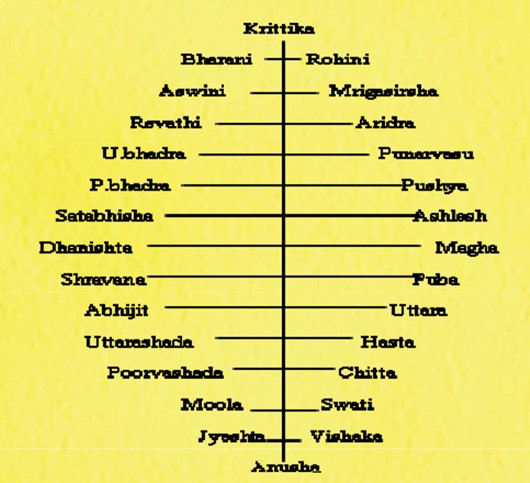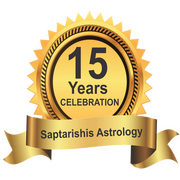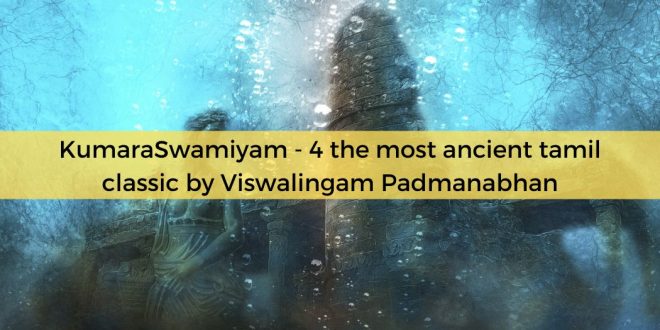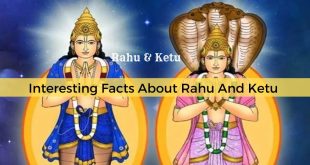Related Articles
Copy Editor: R. Ramanathan
A ‘Mission Saptarishis’ Initiative
Tamil is one of the most ancient Indian languages & there are many classical Jyotisha secrets in Tamil literature that cannot be found elsewhere in Indian languages. One such is ‘KumaraSwamiyam’ & many scholars have given it the highest pedestal attributing their phenomenal predictions to this classic. In Tamil language, Kumaraswami means Lord Muruga son of Lord Shiva. Initially Lord Shiva is telling astrology to Lord Muruga here & he in return passes it on to Rishi Agasthiyar (Agasyta) that our current deeds are based on past karma.
In the translation assignment, this author has striven very hard to give below the best possible translation from his knowledge & trust many will agree. If they have some corrections/suggestions on the same, they can contact us. One will appreciate & understand how difficult it is to translate from a traditional epic given in poetic Tamil of good olden days, into modern Tamil and then into English. It is a very painstaking job that deserves accolades.
Please find below this ancient text continued from previous parts.
The Inauspicious Hours In Transit Of Stars
The duration of inauspicious period of Four Nazhigai** will arise after the rise of the stars as detailed below:
|
| As per Kala Prakashika (Chap.32) | As per | Kala Vidhana Paddhathi | As per Kumaraswamiyam |
| ||||
|
| (Verse 483) | (Verse II(5) |
|
| |||||
|
|
|
|
|
| |||||
S. | Star | 4 Ghatis |
| 3.45 |
|
| 4 Ghatis |
|
|
|
| Ghatis |
|
|
|
|
| ||||
No. | after | Span of Visha Ghati |
| Span of Visha Ghati | after |
| Span of Visha Ghati |
| ||
| after |
|
|
| ||||||
|
| (In | after the rise of Star |
| after the rise of Star | (In |
| after the rise of Star |
| |
|
| (In |
|
|
| |||||
|
| Ghatis) |
|
|
| Ghatis) |
|
|
| |
|
|
| Ghatis) |
|
|
|
|
| ||
1 | Aswini | 50 | 20 hrs to 21.36 hrs | 50 |
| 20 hrs to 21.30 hrs | 50 |
| 20 hrs to 21.36 hrs |
|
2 | Bharani | 24 | 9.36 hrs to 11.12 hrs | 24 |
| 9.36 hrs to 11.06 hrs | 24 |
| 9.36 hrs to 11.12 hrs |
|
3 | Krittika | 30 | 12 hrs to 13.36 hrs | 30 |
| 12 hrs to 13.30 hrs | 30 |
| 12 hrs to 13.36 hrs |
|
4 | Rohini | 40 | 16 hrs to 17.36 hrs | 40 |
| 16 hrs to 17.30 hrs | 40 |
| 16 hrs to 17.36 hrs |
|
5 | Mrigasira | 14 | 5.36 hrs to 7.12 hrs | 14 |
| 5.36 hrs to 7.06 hrs | 14 |
| 5.36 hrs to 7.12 hrs |
|
6 | Aridra | 21 | 8.24 hrs to 10 hrs | 21 |
| 8.24 hrs to 9.54 hrs | 21 |
| 8.24 hrs to 10 hrs | (5) |
7 | Punarvasu | 30 | 12 hrs to 13.36 hrs | 20 |
| 8 hrs to 9.30 hrs | 30 |
| 12 hrs to 13.36 hrs | |
|
|
| ||||||||
8 | Pushyami | 20 | 8 hrs to 9.36 hrs | 20 |
| 8 hrs to 9.30 hrs | 20 |
| 8 hrs to 9.36 hrs |
|
9 | Aslesha | 32 | 12.48 hrs to 14.24 hrs | 32 |
| 12.48 hrs to 14.18 hrs | 32 |
| 12.48 hrs to 14.24 hrs |
|
10 | Makha | 30 | 12 hrs to 13.36 hrs | 30 |
| 12 hrs to 13.30 hrs | 30 |
| 12 hrs to 13.36 hrs |
|
11 | Pubba | 20 | 8 hrs to 9.36 hrs | 20 |
| 8 hrs to 9.30 hrs | 20 |
| 8 hrs to 9.36 hrs |
|
12 | Uttara | 18 | 7.12 hrs to 8.48 hrs | 18 |
| 7.12 hrs to 8.42 hrs | 18 |
| 7.12 hrs to 8.48 hrs |
|
13 | Hasta | 22 | 8.48 hrs to 10.24 hrs | 21 |
| 8.24 hrs to 9.54 hrs | 22 |
| 8.48 hrs to 10.24 hrs |
|
14 | Chitta | 20 | 8 hrs to 9.36 hrs | 20 |
| 8 hrs to 9.30 hrs | 20 |
| 8 hrs to 9.36 hrs |
|
15 | Swati | 14 | 5.36 hrs to 7.12 hrs | 14 |
| 5.36 hrs to 7.06 hrs | 14 |
| 5.36 hrs to 7.12 hrs |
|
16 | Visakha | 14 | 5.36 hrs to 7.12 hrs | 14 |
| 5.36 hrs to 7.06 hrs | 14 |
| 5.36 hrs to 7.12 hrs |
|
17 | Anuradha | 10 | 4 hrs to 5.36 hrs | 10 |
| 4 hrs to 5.30 hrs | 10 |
| 4 hrs to 5.36 hrs |
|
18 | Jyeshta | 14 | 5.36 hrs to 7.12 hrs | 14 |
| 5.36 hrs to 7.06 hrs | 14 |
| 5.36 hrs to 7.12 hrs |
|
19 | Moola | 20 | 8 hrs to 9.36 hrs | 20 |
| 8 hrs to 9.30 hrs | 20&56 |
| 8 hrs to 9.36 hrs |
|
|
|
|
|
|
|
|
|
| 22.24 hrs to 24 hrs |
|
20 | Poorvashada | 24 | 9.36 hrs to 11.12 hrs | 24 |
| 9.36 hrs to 11.06 hrs | 24 |
| 9.36 hrs to 11.12 hrs |
|
21 | Uttarashada | 20 | 8 hrs to 9.36 hrs | 20 |
| 8 hrs to 9.30 hrs | 20 |
| 8 hrs to 9.36 hrs |
|
22 | Sravana | 10 | 4 hrs to 5.36 hrs | 10 |
| 4 hrs to 5.30 hrs | 10 |
| 4 hrs to 5.36 hrs |
|
23 | Dhanishta | 10 | 4 hrs to 5.36 hrs | 10 |
| 4 hrs to 5.30 hrs | 10 |
| 4 hrs to 5.36 hrs |
|
24 | Satabhisha | 18 | 7.12 hrs to 8.48 hrs | 18 |
| 7.12 hrs to 8.42 hrs | 18 |
| 7.12 hrs to 8.48 hrs |
|
25 | Poorvabhadra | 16 | 6.24 hrs to 8 hrs | 16 |
| 6.24 hrs to 7.54 hrs | 16 |
| 6.24 hrs to 8 hrs |
|
26 | Uttarabhadra | 24 | 9.36 hrs to 11.12 hrs | 24 |
| 9.36 hrs to 11.06 hrs | 24 |
| 9.36 hrs to 11.12 hrs |
|
27 | Revathi | 30 | 12 hrs to 13.36 hrs | 30 |
| 12 hrs to 13.30 hrs | 30 |
| 12 hrs to 13.36 hrs |
|
(Note: two & half nazhigai will make one hour)
(**Copy Editor’s Note: This verse is explaining Visha Ghati of the Nakshatras, which is also known as Nakshatra Tyajyam. Regarding the time duration and its time of occurrence, different opinions are prevailing. Hence, for easy reference and comparison, a speculum has been tabulated here with equivalent time in hours)
Stars as Friends or Foes (beneficial or inimical),
Relative panjapatchi, kendantham & Widowhood
Moola, Pushyami, Hasta, Rohini, Revati, Sravana, Uttarabhadra & Aridra are mutual Friends & their influence on each other are mutually beneficial. Hostility exists between Jyeshta & Bharani, Anuradha & Krittika, Visakha & Rohini, Swati & Mrigasira, Dhanishta
- Aridra, Sravana & Punarvasu, Uttarashada & Pushyami, Poorvashada and Aslesha, Revati & Makha, Uttarabhadra & Pubba, Poorvabhadra & Uttara, Satabhisha and Hasta.
Chitta (Chitra) & Moola are hostile towards Aswini. Aswini & Moola are hostile towards Chitta, Aswini & Chitta are hostile towards Moola.
Owl – Aridra, Punarvasu, Pushyami, Aslesha, Makha & Pubba belong to Owl, Crow – Uttara, Hasta, Chitta, Swati & Visakha belong to Crow,
Cock – Anuradha, Jyeshta, Moola, Poorvashada, Uttarashada & Sravana belong to Cock, Peacock – Dhanishta, Satabhisha, Poorvabhadra, Uttarabhadra & Revati belong to Pea cock, Royal Falcon – Aswini, Bharani, Krittika, Rohini & Mrigasira belong to Royal Falcon,
The first quarter of Aswini, Makha & Moola and fourth quarter of Aslesha, Jyeshta and Revati in Kendantham1 and Punarvasu is a widow star.
Kalaignanapaadham, Avasiddhu Stars, Agni(Katthiri) Star
Vainasiyam, evil stars, Paadavaari star & details of stars in Rasi
The 64th division of one’s birth star is known as Kalaignana Paadham. The period of 15 Nazhigai in the fourth quarter of Uttarashada and 4 nazhigai & 4 seconds in the first Quarter of Sravana is termed as Avasiddhu, the period Sun transits from the 3rd quarter of Bharani to the 1st quarter of Rohini is termed as agni natchatthiram, 88th division of one’s
Birth star is known as Vainasiyam, the star at the time of eclipse, three stars preceding and three stars following it are deemed to be bad and the following 9 stars viz., Aswini, Bharani, Satabhisha, Anuradha, Jyeshta, Moola, Swati, Visakha & Sravana are termed as Paadavaari.
(note: As the words in italics are in native language, they could not be translated )
The stars Aswini, Bharani & 1st quarter of Krittika represent ‘Aries’ rasi, the balance 3 Quarters of Krittika, Rohini & 1st & 2nd quarters of Mrigasira represent ‘Taurus’ rasi, the Balance 3rd & 4th quarters of Mrigasira, Aridra & 1st,2nd & 3rd quarters of Punarvasu Represent ‘Gemini’ rasi, the balance 4th quarter of Punarvasu, Pushyami & Aslesha rasi represent ‘Cancer’ rasi,
Star Makha, Pubba, & 1st quarter of Uttara form ‘Leo’ rasi, the balance 2 nd, 3rd & 4th Quarters of Uttara, Hasta & 1st & 2nd quarters of Chitta form ‘Virgo’ rasi, the balance 3rd And 4th quarters of Chitta, Swati, 1st, 2nd &3rd quarters of Visakha form ‘Libra’ rasi, 4th Quarter of Visakha, Anuradha & Jyeshta form ‘Scorpio’ rasi, Moola, Poorvashada and The 1s quarter of Uttarashada form ‘Sagittarius’ rasi, the balance 2nd, 3rd & 4th quarters of Uttarashada, Sravana & 1st & 2nd quarters of Dhanishta form ‘Capricorn’, rasi, 3rd & 4th Quarters of Dhanishta Satabhisha, 1st, 2nd & 3rd quarters of Poorvabhadra form ‘Aquarius” rasi and 4th quarter of Poorvabhadra, Uttarabhadra, & Revati form Pisces rasi.
Kiraga udaippu 0r thulpthai, Kiraga vedhai Kiraga vedhaiyin thogai Kiraga Vedhaiyin peyar.
The Sun’s udaippu, shall occur on the 12th star from the star it transits, that of Moon shall Occur on the 22nd star from the star it transits, that of Mars (and not Jupiter as mentioned In the printout sent) shall occur on the 3rd star from the star it transits, that of Mercury shall occur on the 7th star from the star it transits, that of Jupiter shall occur on the 6th star From the star it transits, that of Venus shall occur on the 5th star from the star it transits, That of Saturn shall occur on the 8th star from the star it transits & those of Rahu/ketu
Shall occur On the 9th star from the star they transit. (Udaippu inferred as collision). The Sun’s vedhai, shall occur on the 5th, 7th, 8th, 14th, 23rd, 10th, 15th, 18th, 21st, 22nd & 27th Stars from the star it transits, that of Mars shall occur on the 7th, 21st, 15th, 10th Stars From the star it transits, that of Mercury shall occur on the 24th,18th & 8th stars from The Star it transits, that of Jupiter shall occur on the 9th, 7th stars from the star it transits,
That of Venus shall occur on the 9th, 7th stars from the star it transits, that of Saturn shall Occur on the 5th, 6th, 20th, 11th, 10th stars from the star it transits & those of Rahu/Ketu Shall occur on the 7th star from the star they transit.
(Note: The counts for Sun, Mars, Jupiter & Saturn is clockwise & for Moon, Mercury, Venus, Rahu & Ketu is anti clockwise)
Sun’s Vedhai on the eleven stars mentioned shall bring about bhiramam (inferred as confusion), earth quake, soolam, quarrels, padai soonyam, lies, kethu (presumably Printing error, cross check if this refers as Kedu meaning disaster), analthandham & Dosham (evil), Mar’s Vedhai on the four stars mentioned shall result in sakkaram,
Death messenger, critical period & soolam, Mercury’s Vedhai on the three stars Mentioned shall result in death, Jupiter’s Vedhai on the two stars mentioned shall result In difficult times, Venus’s Vedhai on the two Stars mentioned shall result In viranam, Saturn’s Vedhai on the five stars mentioned shall result in paasabhandhanam and Rahu/Ketu Vedhai shall result in nibham.
(Wherever possible the scribe has translated the technical words in English. Some of the words are in a language other than Tamil. Readers are requested to take caution & verify the meaning of these words, which are in native language)
Nithyagrahavedhai, Tharkaaliyak kiragavedhai, Samugadekshanavaamavedhai Saangathiyam, Samuthaayikam, Aathaanam, Desammanatham, Saathi abishekam.
Mars in seventh star from the star which the moon transits, Mercury in fourth star from The star which mars transits, Jupiter in fifth star from the star which Mercury transits, Venus in sixth star from the star which Jupiter transits, Saturn in eighth star from the star Which Venus transits, Sun in ninth star from the star which Saturn transits, Rahu/ketu in Ninth star from the star which Sun transits and Moon in ninth star from the star which Rahu/Ketu transits are considered to be nithyagrahavedhai. Ketu in fifteenth star from The star which Sun transits, Mercury in eighteenth star from the star which Ketu transits, Saturn in seventeenth star from the star which Mercury transits, Jupiter in twelfth star From the star which Saturn transits, Rahu in twelfth star from the star which Jupiter
Transits, Mars in twelfth star from the star which Rahu transits, Moon in twelfth star From the star which Mars transits and Sun in twelfth star from the star which Moon Transits are considered to be tharkaaliyak Kiragavedhai.
The following table will depict stars that would cause samuga vedhai, dekshana vedhai Vaama vedhai in respect of stars given there against:
Stars | Samugavedhai | Dekshanavedhai | Vaamavedhai | ||||||
|
| Stars |
|
| Stars |
|
| Stars |
|
Aswini | Pubba |
| Jyeshta | Rohini | |||||
Bharani |
| Uttara |
| Moola |
| Mrigasira | |||
Krittika |
| Hasta | Poorvashada | Aridra | |||||
Rohini |
| Chitta | Uttarashada | Punarvasu | |||||
|
|
|
| 747 |
|
|
| ||
Mrigasira | Swati | Sravana | Pushyami |
Aridra | Visakha | Dhanishta | Aslesha |
Punarvasu | Anuradha | Satabhisha | Makha |
Pushyami | Jyeshta | Poorvabhadra | Pubba |
Aslesha | Moola | Uttarashada | Uttara |
Makha | Poorvashada | Revati | Hasta |
Pubba | Uttarashada | Aswini | Chitta |
Uttara | Sravana | Bharani | Swati |
Hasta | Dhanishta | Krittika | Visakha |
Chitta | Satabhisha | Rohini | Anuradha |
Swati | Poorvabhadra | Mrigasira | Jyeshta |
Visakha | Uttarabhadra | Aridra | Moola |
Anuradha | Revati | Punarvasu | Poorvashada |
Jyeshta | Aswini | Pushyami | Uttarashada |
Moola | Bharani | Aslesha | Sravana |
Poorvashada | Krittika | Makha | Dhanishta |
Uttarashada | Rohini | Pubba | Satabhisha |
Sravana | Mrigasira | Uttara | Poorvabhadra |
Dhanishta | Aridra | Hasta | Uttarabhadra |
Satabhisha | Punarvasu | Chitta | Revati |
Poorvabhadra | Pushyami | Swati | Aswini |
Uttarabhadra | Aslesha | Visakha | Bharani |
Revati | Makha | Anuradha | Krittika |
The 4th star from the each star is vaama vedhai star, 11th star is samuga vedhai star, 18th star is Dekshina vedhai star.
The 16th star from birth star is Saangathiyam, 18th star is Samuthayigam, 19th star is Aadhaanam, 24th star is Desam, 25thstar is Maanatham, 26th star is Saathi, 27th star is Abishegam.
Natshetrapaarvai (Star’s aspect), Dekshanavedhai, Vaamavedhai, Karnavedhai, Naarkonavedhai, samugavedhai
The star transited by Sun will aspect its 26th,16th,8 th,7th, 21st, 11th stars, the star transited by Moon will aspect its 4th, 8th, 18th, 15th, 10th stars, the star transited by Mars will aspect its 3rd, 15th, 7th, 8 th stars, the star transited by Mercury, Jupiter, Venus &Saturn will aspect Its respective 3rd & 5th Stars. The aspect of star transited by Saturn on its 19th & 15th stars And the aspect of star transited by Jupiter on its 19th & 10th stars are considered to be Athigap parvai (conferring higher intensity).
The 5th, 6th, 7th, 8th, 12th, 13th, 14th stars from the star transited by Saturn & Mars are
Dekshanavedhai stars, 17th 18th, 19th, 22nd stars are vaamavedhai stars, 2nd, 15th, 16th, stars Are karnavedhai, 26th, 21st, 3rd, 20th stars are naarkonavedhai and 4th, 9th 10th, 11th, 23rd, 24th, 25th, 27th
stars are samugavedhai.
Domicile of Stars & Natchathira Thaesam
The domicile (abode) of Aswini star is oor (city or village), for Bharani it is tree, for Krittika it is Forest, for Rohini it is gruel pot, for Mrigasira it is below a cot, for Aridra it is below a Static chariot, for Punarvasu it is a huge earthen receptacle for storing grains, for Pushyami it is land meant for construction, for Aslesha it is a place where unwanted.
Things are stacked for clearance i.e. rubbish, for Makha it is paddy shoots or buds, for Pubba it is empty house2, for Uttara it is water, for Hasta it is water shore or bank, for Chitta it is farmland, for Swati it is cotton, for Visakha it is courtyard or open space, for Anuradha it is secluded & un inhabitated place, for Jyeshta it is shopping place, for Moola It is horse stable, for Poorvashada it is terrace, for Uttarashada it is place where dhobi Washes clothes for Sravana it is place of worship (temple), for Dhanishta it is factory (inferred to be crushing factory) for Satabhisha it is oil press, for Poorvabhadra it is street, For Uttarabhadra it is fire yard, and for Revati it is flower garden. Recite the alphabet as Applicable to the respective star as a tribute to it (reciting the natchathira thaesam).
Subha Natchathiram, asubha natchathiram, mahadisai natchathiram, abuttha moolam, Stars with Two Eyes, Stars with One Eye & Blind stars
Aswini transited by Mars, Anuradha transited by Mercury, Pushyami transited by Jupiter, Revati transited by Venus, Rohini transited by Saturn, Hasta transited by Sun & Sravana Transited by Moon are stars conferring good values Whereas stars Uttarashada transited By Mars, Dhanishta transited by Mercury, Jyeshta transited by Jupiter, Poorvashada
Transited by Venus, Revati transited by Saturn, Bharani transited by Sun and Chitta Transited by Moon are evil stars. The period of two nazhigais from the first nazhigai after The rise Of Moola Is termed as abuttha moolam. Uttara for Sun, Hasta for Moon, Chitta For Mars, Swati for Rahu, Visakha for Jupiter, Anuradha for Saturn, Jyeshta for Mercury,
Moola for Ketu and Poorvashada for Venus are considered as mahadisai stars. The star Transited by Sun, the preceding 3 and succeeding 3 stars (aggregating 7 stars) are termed As Kuruttu Nakshetram (Blind Stars). The preceding 4 & succeeding 4 stars to Kuruttu Nakshetram (Blind stars) are with One Eye and the remaining stars have two eyes.
Natchetra Rogam, Natchetra Avamirutthu,
Anarchigai, gurudosham
The 1st quarter of Aslesha & Uttarabhadra, 2nd quarter of Bharani & Moola, 3rd quarter of Sravana & Uttara, and 4th quarter of Mrigasira & Swati are rogam stars (rogam stars inferred to mean disease conferring stars), 3rd quarter of Aslesha & Uttarabhadra, 4th Quarter of Bharani & Moola, 1st quarter of Dhanishta & Hasta and 2nd quarter of Aridra And Visakha are avamirutthu, The period of, 7 ¾ nazhigai from 7 3/4th nazhigai after
The rise of Aswini, Rohini, Punarvasu, Makha & Hasta, 5 nazhigai from 55th nazhigai After the rise of Bharani, Mrigasira, Pushyami, Pubba & Chitta, 9 nazhigai from 21st Nazhigai after the rise of Krittika, Aridra, Aslesha, Uttara & Swati, the first 8 nazhigai After the rise of Visakha, Moola, Sravana & Poorvabhadra, the last 8 nazhigai in Anuradha, Poorvashada, Dhanishta & Uttarabhadra and 10 nazhigai from 20th nazhigai After the rise of Jyeshta, Uttarashada, Satabhisha & Revati are anarchigai stars. If the Star that rises between the fall of New Moon and the rise of Prathamai thithi is coincided with vidakadigai (Visha Ghati), it is termed as Gurudosham. Resident of Pothigai mount, Sage Agasthian Was told as above.
Natshetrayogam can be obtained by counting the number of days from the star Visakha Transited by sun, Poorvashada transited by moon, Dhanishta transited by Mars, Revati Transited by Mercury, Rohini transited by Jupiter, Pushyami transited by Venus and Uttara transited by Saturn to the respective star on a particular day desired and divide the Resultant figure by 7. If the reminder after the multiples of seven is 1 it denotes irutthai yogam, 2 denotes naasam (disaster), 3 denotes death, 4 denotes amirtham (inferred as longevity), 5 denotes subham (welfare), 6 denotes siddham, 7 denotes parigam. Asubha subhang koodil Visha yogam.
Draw** a vertical straight line. Draw 13 lines across horizontally as described in the extract. Starting from the top of the vertical straight line assign star Krittika. Assign at the end of Each line the names of stars clockwise as described in the extract. On a particular day Ascertain the star opposite to the one transited by Sun. The planet/planets that transit(s) This star is/are termed as Ekaarkalam. The last 2 nazhigai of star is Aagulam
(Note: words in italics are in native language. Wherever possible the English equivalent is given)
- See the diagram below

Learn Astrology: Join Our Upcoming Astrology Classes — Click Here
Learn Astrology: Join Our Recorded Astrology Classes — Click Here
 Saptarishis Astrology Magazine Into Creating Astrologers
Saptarishis Astrology Magazine Into Creating Astrologers






